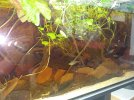Bagsofsmoke
New Member
- Messages
- 8
Hi all,
I'm new to the forum. I am setting up a 300l (80 US gallon) rimless Amazon biotope aquarium. It will be blackwater, with moderate planting and CO2, and lots of botanicals, wood etc.
I plan to stock with:
30 x tetras (species TBD), or possibly 2 x 15 of 2 different species
1-2 x Ancistrus
6 x Otocinchlus
8 corydoras (species TBD)
I would really like to keep some apistogramma (cacatuoides) and / or some rams. I have kept larger central and south american cichlids before (Firemouths and Blue Acaras) but never dwarf cichlids.
In a tank that size, would it be feasible to keep 1 male apistogramma and 3-4 females? Or a male / female pair and then a small group of rams?
I've also seen quite different temperature ranges given for apistogramma cacatuoides, from 24-27 C to 26-29 C. Advice welcome!
I'm keen to ensure the water parameters are as suitable as possible for the intended species.
Thanks in advance for your assistance.
I'm new to the forum. I am setting up a 300l (80 US gallon) rimless Amazon biotope aquarium. It will be blackwater, with moderate planting and CO2, and lots of botanicals, wood etc.
I plan to stock with:
30 x tetras (species TBD), or possibly 2 x 15 of 2 different species
1-2 x Ancistrus
6 x Otocinchlus
8 corydoras (species TBD)
I would really like to keep some apistogramma (cacatuoides) and / or some rams. I have kept larger central and south american cichlids before (Firemouths and Blue Acaras) but never dwarf cichlids.
In a tank that size, would it be feasible to keep 1 male apistogramma and 3-4 females? Or a male / female pair and then a small group of rams?
I've also seen quite different temperature ranges given for apistogramma cacatuoides, from 24-27 C to 26-29 C. Advice welcome!
I'm keen to ensure the water parameters are as suitable as possible for the intended species.
Thanks in advance for your assistance.



